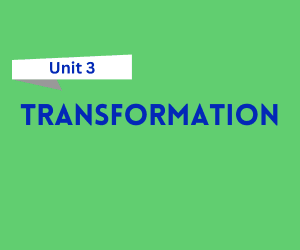
Free Download Transformation Notes in pdf – Bca 6th Semester. High quality, well-structured and Standard Notes that are easy to remember.
Click on the Download Button 👇
Transformation in Computer Graphics
In computer graphics, transformation refers to the process of manipulating objects or shapes in a graphical space. It involves modifying the position, size, orientation, and shape of objects within a coordinate system, either in 2D or 3D space. Transformations are essential for rendering and animating objects in graphics applications such as games, simulations, and design software.
Key Points about Transformation
Definition:
- Transformation: A mathematical operation that changes the position, size, or orientation of objects in a graphical scene.
Types of Transformations:
- Translation: Moves an object from one position to another without altering its shape or size.
- Scaling: Changes the size of an object, either enlarging or reducing it.
- Rotation: Rotates an object around a specific point or axis.
- Shearing: Distorts an object by shifting parts of it along one axis while keeping other parts fixed.
- Reflection: Flips an object over a specific axis, creating a mirror image.
Coordinate Systems:
- Transformations are applied based on a coordinate system (e.g., Cartesian coordinates), with the origin often being the reference point.
Matrix Representation:
- Transformations are often represented by matrices in computer graphics. A transformation matrix can be multiplied by the coordinates of an object to apply the transformation.
Features of Transformation
- Modularity: Transformations can be combined (e.g., scaling and rotation) to achieve complex effects.
- Consistency: Transformations can be consistently applied across all elements of a scene or object, ensuring uniformity.
- Real-Time Updates: Transformations can be applied dynamically in real-time, enabling animations and interactive applications.
- Coordinate Flexibility: Transformations can occur in 2D or 3D space, depending on the application’s needs.
- Combination: Multiple transformations can be applied sequentially or simultaneously to achieve the desired result.
FAQs on Transformation in Computer Graphics
Q1: What are the main types of transformations in computer graphics?
- Translation: Moves an object to a new location.
- Scaling: Changes the size of an object.
- Rotation: Rotates an object around a fixed point or axis.
- Shearing: Distorts the shape of an object.
- Reflection: Creates a mirror image of an object.
Q2: How are transformations applied in computer graphics?
Transformations are typically represented using transformation matrices. These matrices are multiplied by the coordinates of the object, resulting in a transformed version of the object.
Q3: What is the difference between scaling and translation?
- Scaling: Changes the size of an object, either making it bigger or smaller.
- Translation: Changes the position of an object without altering its size or shape.
Q4: Why are matrices used for transformations?
Matrices are used because they allow for efficient and consistent manipulation of objects. They enable the combination of multiple transformations (e.g., rotation, scaling) into a single operation, making computations easier and faster.
Q5: What is the significance of homogeneous coordinates in transformations?
Homogeneous coordinates are an extension of the regular 2D and 3D coordinate systems that make it easier to represent translations and other transformations using matrices. They allow for the combination of different transformations into a single matrix operation.
Q6: Can transformations be animated?
Yes, transformations can be animated by continuously updating an object’s position, size, or orientation over time, resulting in dynamic effects in animations and interactive graphics.
Q7: What is the difference between 2D and 3D transformations?
- 2D transformations are applied in a two-dimensional plane, dealing with objects that have width and height.
- 3D transformations apply to objects that exist in three-dimensional space, including width, height, and depth, and involve additional considerations like the object’s orientation in 3D space.